30.11.2005
S. IONOV. PORTRAIT OF A CHESSPLAYER – ALEXANDER KHALIFMAN
Khalifman – Novikov 1.d4 d5 2.c4 e6 3.¤f3 ¤f6 4.g3 dxc4 5.Ґg2 a6 6.0–0 b5 7.¤e5 ¤d5 8.a4 Ґb7 9.axb5 axb5 10.¦xa8 Ґxa8 11.e4 ¤f6 12.¤c3 c6 13.Ґg5. Another possibility is an immediate breakthrough 13.d5. 13...Ґb7. More reliable is 13...Ґе7 14.Ја1 Ґb7 15.Јa7 Јc8 16.d5 0–0 17.de6 fe6 18.Ґh3 ¤ with mutual chances. 14.¤xf7!? 14...ў xf7 15.e5 h6 16.Ґh4. White retains compensation for a sacrificed piece also after 16.Ґf6 gf6 17.Јh5 ўg7 18.¦a1 f5 19.¤e2 ¦g8 20.¤f4, as it was in a correspondence game Nesis – Blok, 1985. 16...¤bd7?! Having run across an unexpected novelty, Black did not decide on the principled 16...g5! 17. ef6 Јf6 18.¤e4 Јg6 19.Јa1 ¤a6! cutting off the access to his camp, and it would be hard for White to prove his case. 17.exf6 ¤xf6 18.Ґxf6 gxf6 (18...Јf6 19.¤e4 with unpleasant initiative) 19.Јh5+ ўg7 20.¦a1 ¦h7. Novikov instinctively wants to protect the seventh rank from white rook's invasion, but disaster comes from a different side. 20...¦g8!? can be proposed and in case of 21. ¤e2 Ґd6 22.d5 cd5 23.¤d4 Black has 23...Је8 with chances for a successful defense. 21.¤e2 Ґd6. It seems that Black covered his vulnerable squares, but the breach happened in the most fortified spot. 22.d5! The knight joins the attack of the main weakness of Black – the e6-pawn. 22...cxd5. Very bad is 22...ed5 23.¤d4 ўh8 24.Ґh3! Ґe5 25.Ґf5 Ґd4 26.Ґh7 Јe7 (26...Ґb2 27.¦e1) 27.Ґf5 Ґb2 28.¦a7 Ґd4 29.¦b7 Јe1 (29...Јb7 30.Јh6 ўg8 31.Ґe6 with a mate) 30.ўg2 Јf2 31.ўh3 Јf1 32.ўh4, and white king escapes from checks. 23.¤d4 Ґc8? A decisive mistake. The struggle remained tense after 23...Јg8 24.Ґh3 Јf7 25.Јe2 f5 26.¤e6 ўh8 27.¤d4 Јe7 ( worse is 27...f4 28.¦e1 with initiative) 28.Јh5 Ґc5. However, White has another way of developing his attack: 24.¦a7 ўh8 25.¦b7! ¦b7 26.Јh6 ¦h7 27.Јf6 Јg7 28.Јe6 and now 28...Јe5 (28...Јd4? 29.Ґd5) 29.Јc8 ўg7 30.¤f5 ўg6 (30...ўf6 31.¤e3) 31.Јg8, but it seems that Black is rescued by 28...Јh6 29.Јh6 ¦h6 30.¤b5 Ґc5 (30...d4!?) 31.Ґd5 ¦f6 32.Ґc4 ¦f2. 24.¦a8 Јd7 25.¤xe6+! A beautiful blow, however no less efficient was 25. Јg4 ўf7 26.¦c8! Јc8 27.Ґd5 ўe7 28.Јe4. 25...Јxe6 26.Ґxd5 26...Јd7 (26...Јe1 27.ўg2 Ґe6 28.Јg4! Ґg4 29.¦g8 a mate! ) 27.¦xc8! Јxc8 28.Јf7+ ўh8 29.Јxf6+ ¦g7 30.Јxh6+ ¦h7 31.Јxd6. In spite of the fact that Black is not in a very bad situation as regards material, unsafe position of the king kills him. 31...¦g7 32.Јh6+ ¦h7 33.Јf6+ ¦g7 34.h4 Јe8 35.Ґe6! Јe7 36.Јe5 Јb7 37.Јh5+ ¦h7 38.Јe8+ ўg7 39.Јg8+ ўf6 40.Ґd5 Black resigned. A few people could hit on an idea of such a bold piece sacrifice! Alexander cogently refuted a risky opening strategy of his opponent in the next miniature. Khalifman – Basin 11.dxe5 ¤xe5 12.¤xe5 Ґxe5 13.f4 Ґd4+. Lately Black tries keeping this position with the help of 13...Ґc3 14.bc3 c6!? 14.Ґe3 Ґc6? This natural response hits runs across a refined refutation. Black made an attempt of rehabilitating the variation in the game Vallejo – Korneev, Spain 2004: 14...Ґe3 15.Јe3 b4!? 16.¤e2 Јe7 17.e5, and instead of 17...¦d8 18.Јa7 with a small advantage to White deserved attention 17...¤g4 18.Јe4 ¦d8 ( or 18...0–0) with unclear position. However, also possible is simple 16.¤d5 ¤d5 17.ed5 Јe7 18.Јe7 ўe7 19.d6 cd6 20.¦fe1 ўf6 21.Ґa8 ¦a8 22.¦ad1 with advantage. 15.e5! 15...Ґxg2 16.ўxg2 Ґxe3. Leads to material losses, but 16...¤g8 17.¦d1 c5 18.Јg4 ўf8 19.f5 is also joyless for Black. 17.exf6 Јd2 18.¦f2! 18...0–0–0 19.Јg4+ Јd7 20.Јf3! Јd4 21.¦e2 Јxf6 22.¦xe3 ўb8 23.¦ae1 Black resigned. Khalifman – Ivanchuk 1.d4 d5 2.c4 e6 3.¤f3 ¤f6 4.g3 dxc4 5.Ґg2 ¤c6 6.0–0 ¦b8 7.¤c3 a6. It's quite possible to save on the move 7...а6 and advance the b-pawn immediately – 7...b5. 8.e4 b5 9.Јe2!? An unexpected sacrifice of the second pawn. More popular is 9. d5 ¤b4 10.b3! with a weighty compensation for a pawn. 9...¤xd4 10.¤xd4 Јxd4 11.Ґg5 Јb6. 11...Ґb7 12.¦ad1 Јb6 deserved attention and it's not an easy task for White to prove the propriety of his plan. 12.e5 ¤d5?! Stronger was 12...¤d7 13.¦ad1 Ґc5 14.¤e4 0–0 15.¦d7 Ґd7 16.¤f6 gf6 17Ґf6, and after the only response 17...¦fd8! comes a draw – 18.Јg4 ўf8 19.¦d1 ўe8 20.Јg8 Ґf8 21.Ґg7 ўe7 (21...Јc5 22.¦d6) 22.Ґf6. Black can play for a win13...Ґb7 14.Јd2 Ґd5 15.¤c5 Јc5 16.Ґd5 Јd5 17.Јd5 ed5 18.¦d5 ¤b6 or 13...Ґd4 14.Јg4!? Ґe5 (14...¤e5 15.¦d4! c5 16.¤d6 ўf8 17.Јe2) 15.Ґe3 c5 16.f4 Ґb2 17.¤d6 ўe7 18.f5 with immense complications. 13.Ґxd5! exd5 14.¤xd5 Јb7. Another retreat of the queen was possible – 14...Јc6 15.¦ad1 Ґe6 (15...Ґb7? 16.e6! (16.¤f6! gf6 17.ef6 Јe6 18.Јd2 Ґd6 19.¦fe1 Ґe4 20.Јd4 0–0 21.¦e4 Јf5 22.Јe3 Ґc5 23.Јe3 with big advantage ) 16...Ґd6 (16...fe6 17.Јh5 g6 18.Јf3 Јd5 (18...Ґg719. ¦fe1) 19.¦d5 Ґd5 20.Јf6 ¦g8 21.¦d1! ¦g7 22.¦d5 ed5 23.Јe6 ±) 17.Ґe7! Ґe7 18.ef7 ўf7 19.Јe7 ўg8 20.¦fe1 with a strong attack) 16.Јf3 Ґd5 17.¦d5 Јe6 18.¦fd1 Ґe7 19.Ґe7 Јe7 20.¦d7 Јe6. 15.¦ad1 Ґh3? More careful was 15...Ґe6, however, White's initiative there is also unpleasant: 16.¤f4; 16.Јf3 c6 (16...Ґd5 17.¦d5 c6 18.¦d4 Ґc5 19.¦g4 Јd7 20.e6! fe6 21.¦d1) 17.¤f4 (17.¤f6? gf6 18.Јf6 Јe7). 15...h6 leads to head-spinning complications: 16.Јd2 (16.¤c7 Јc7 17.¦d8 Јd8 18.Ґd8 ўd8 19.Јf3 ўe8 20.¦d1 Ґd7 21.e6! fe6 22.Јh5 – White's initiative compensates a material deficit). Now wrong is 16...hg5? 17.¤f6 ўe7 18.¤d7! (much stronger than suggesting itself 18.Јd8 ўe6 19.Јe8 Ґe7 20.Јh8 Јh1! (20...gf6? 21.Јh3 g4 22.Јg4 f5 23.Јg7 with decisive threats) 21.ўh1 Ґb7 with a perfect position for Black) 18...f6 19.¦fe1, and Black will suffer. For example, 19...ўf7 20.e6 ўg6 21.Јc2 ўh6 22.¤b8 Ґd6 23.Јf5 g6 24.Јh3 ўg7 25.Јh8! ўh8 26.e7 Ґe7 27.¦e7 Ґe6 28.¦e6 Јb8 29.¦de1! ўg7 30.¦e8 Ј~ 31.¦1e7 ўh6 32.¦h8#. White's tasks are more difficult after the bishop's move: 16...Ґe6 17.¤f4 (17.¤f6 gf6 18.Ґf6 Ґe7 19.Ґh8 Ґh3 with approximately level position) 17...Јc8 18.¤e6 fe6 19.Ґe3 with sufficient compensation for a pawn; 16...Ґh3 17.¤f4 (17.¦fe1 hg5 18.¤f6 ўe7 19.¤d5=; 17. Ґh4!?) 17...hg5 18.¤h3 Ґe7 with mutual chances; 16...Ґg4 17.Ґd8!? Ґc5 (17...¦c8 18.¦fe1 (18.Ґc7!?) 18...Јc6 19.Јd4 Ґd1 20.¤f6 gf6 21.ef6 Ґe7 22.Ґe7 Јd7=) 18.¤c7 ўf8 19.Јd5=. 16.e6! 16...Ґxe6 17.Јe5 Ґd6™ 18.Јxg7 ўd7 19.¤f6+ ўc6 20.¤e4. It's very difficult to defend this position, especially in practical play. 20...Јc8 21.Јd4 Јd7 22.¤f6! Јc8 (more stubborn is 22...Је7) 23.Ґe3! 23...b4. Here there are many ways of winning. The one chosen by White is the most efficient. 24.a4 bxa3 25.bxa3 ¦b3 26.Јe4+ ўb5 27.¦d5+! Ґxd5 28.Јxd5+ c5 29.a4+ ўb6 30.Јxd6+ ўb7 31.Јd5+ Јc6 32.Јxc4 Black resigned. The next encounter became the most memorable win of the Russian championship of 1996. Khalifman – Sveshnikov 1.d4 d5 2.c4 e6 3.¤f3 c6 4.g3 ¤f6 5.Ґg2 dxc4 6.0–0. The alternative to the text move is 6.¤e5 (preventing 6...b5) Ґb4 7.¤c3 or 7.Ґd2!? 6...b5 7.a4 Ґb7 8.¤e5 Јb6. The main continuation is 8...а6. 9.b3!? cxb3 10.Јxb3 ¤bd7. Black did not dare to treat himself to the second pawn, he is too underdeveloped. 14...cxb5 (14...c5 15.¤c4! ўe7 (15...0–0 16.¤d6ќ) 16.e4 ¤b6 (16...¤f6 17.e5 ¤d5 18.¤d6ќ) 17.Ґxg7 ¦g8 18.Ґf6+ќ) 15.Ґxd5 exd5 16.¦c7 Ґa6 17.¤xf7 ¦g8 18.¤g5±. 11.Ґe3 c5. 11...¤d5 12.¤xd7 ўxd7 13.¤d2 – White has a long-term initiative because black king loses the right to castle (13.¤c3?! bxa4 14.Јc4 Јb3). 12.¤xd7 ¤xd7 13.d5!? Regaining the pawn 13.Ґxb7 Јxb7 14.Јxb5 with a small advantage that could be insufficient for a win did not suit Alexander. 13...bxa4. 13...exd5 14.Ґxd5 Ґxd5 15.Јxd5 ¦b8 16.axb5 Јb7 17.¤c3 led to the evident advantage of White. 14.Јxa4 exd5?! Too optimistic. Better was 14...Ґxd5, exchanging a dangerous light-squared bishop – 15.¤c3 Ґxg2 16.ўxg2, and Black has chances to withstand, for example: 16...¦d8 17.¦fd1 Јb7+ 18.f3 Ґe7 19.¦ab1 Јc8 20.Јxa7 Ґf6™ (20...0–0 21.¦b7 Ґf6 22.¦dxd7 ¦xd7 23.¦xd7 Ґxc3 24.Ґxc5±) 21.¦b7 (№ 21.¤e4 0–0 22.¦b7 ¤e5 23.¦xd8 ¦xd8 24.Ґxc5І) 21...Ґxc3 22.¦c7 Јa8 23.¦dxd7 0–0 24.Јxa8 ¦xa8 25.Ґxc5 ¦fc8= 26.¦xf7? Ґe5 27.Ґd6 ¦xc7 28.Ґxc7 ўxf7 29.Ґxe5і. 15.¤c3 d4 (15...Јe6 16.¦fb1 Ґc6 17.¤xd5! Ґxa4 18.¤c7+ ўe7 19.¤xe6ќ; 15...Ґc6 16.¤xd5 Ґxa4 17.¤xb6 axb6 18.Ґxa8ќ) 16.¤d5 (16.¦fb1? Ґxg2!) 16...Ґxd5 17.Ґxd5 ¦d8 18.Ґf4 Јf6 (18...Ґd6 19.¦fb1 Јc7 20.Ґg5!? (20.¦b7 Ґxf4 21.¦xc7 Ґxc7 22.Јb3 0–0 23.¦xa7 Ґb8 (23...Ґe5 24.Ґe6!) 24.¦b7±) 20...Ґe7 21.Ґxe7 ўxe7 22.¦b7 Јd6 23.Ґc6, and no one will envy Black) 19.Јb5! Black's hopes for quiet evacuation are never to be fulfilled! 19...Ґd6 20.¦a6 ¦b8 21.Ґb7! Ґxf4 22.¦xf6 gxf6 23.gxf4 f5 24.Јc6 ўd8 25.Јd5 ўc7 26.Ґc6 Black resigned. It's much more difficult to seize the initiative playing Black. The King's Indian defense stops yielding fruits when entering the dense atmosphere. Adding the Volga gambit into the opening repertoire became a godsend from Alexander. The next game diminished the popularity of one of the main anti-Volga lines mid-nineties. Lalic – Khalifman 7...Јe7 8.Јe2 ¤g8 9.¤c3 Ґb7 10.¤h3 c4 11.Ґe3 (preventing Јс5) 11...axb5 12.0–0–0. The game Ivanov – Khalifman (St. Petersburg 1997) saw 12.¤xb5 Јb4+ 13.¤c3 ¤e7 14.a3 Јa5 15.Јf2 ¦a6! 16.Јd2? (16.b4!? cxb3 17.Ґd2„) 16...¤f5 17.Ґf2 Ґc5 18.¦d1 Ґxf2+ 19.¤xf2 0–0µ, and Black ended the game triumphantly. 12...Јb4 13.¤f4. 13.¦d5 is met by a queen sacrifice with excellent compensation: 13...Јc3! 14.bc3 Ґd5. 14...h5! Bringing the rook into action and almost forcing White to capture on d5. 15.¦xd5 Јxc3+! 16.bxc3 ¤xd5 17.¤xd5 Ґxd5. 18.Јd2 Ґe6 19.Ґe2?! It was necessary to lessen Black's attacking potential by exchanges: 19.Ґc7 ¤c6 20.Ґd6 Ґxd6 21.exd6 0–0©. 19...¤c6 20.f4 b4 21.f5. White counted on this move. 21...bxc3 22.Јxc3 ¦a3! Without granting a respite. 23.Јb2. More stubborn is 23.Јa1 Ґxf5 (23...Ґd5 24.¦d1 ¤b4 25.¦xd5! ¤xa2+ 26.ўd1 ¤c3+ 27.Јxc3 ¦xc3 28.Ґd4 ¦a3 29.Ґxc4) – strong bishops balance the position. Black's initiative is very unpleasant, especially in a practical game. 23...c3 24.Јb5 Ґxf5 25.¦f1. Missing the next move. It was necessary to play 25.Ґc4µ. 25...¦xa2! 26.¦xf5 ¤b4 27.Јa5 (27.Ґd3 ¦a1+ 28.Ґb1 c2 (28...g6? 29.¦f4ќ) 29.Јxb4 Ґxb4 30.ўxc2 ¦h6°) 27...g6! With inevitable Ґh6. White resigned. An interview to Russian TV during the Olympiad in Bled Alexander achieved a good victory over a strong opponent in the main variation of the Volga gambit. Beliavsky – Khalifman 14...¤e8 15.¦c2 ¤b6 16.Јe2 Јa6! The Volga gambit differs from other gambits by the fact that Black aims not at the king but on White's queenside. Black often exchanges queens himself in order to escape a possible White's attack on the kingside. At the same time this exchange weakens White's control over the light squares (c4, d3) in his own camp. 17.¤g1?! Illogical decision. The knight on e2 usually stands passively in the Indian structures. But also after 17.Јxa6 ¦xa6 18.¤d2 f5 19.f3 ¤a4 Black has a compensation for a pawn (given by Khalifman). 17...¤a4. Perhaps one should have waited a little with this thrust and bring the second knight – 17...¤с7. 18.Јxa6 ¦xa6 19.¤ge2 ¤c7 20.a3. A controversial decision that weakens the square b3, but White wanted to release the rook from defending the a-pawn. One should have preferred 20.f3. 20...f5 21.f3 fxe4 22.fxe4 ¤xc3 22...¤b5!? a) 23.¤xb5 ¦xb5 24.¦a2 ¦b3ѓ 25.¤g1!? ¦a8 (25...¦ab6 26.¤f3 ¦b8© (a)26...Ґxb2 27.¤d2; a)26...¤xb2 27.¤d2 ¦c3 28.¦axb2 ¦xb2 29.¦xc3 Ґxc3 30.Ґxb2 Ґxd2 31.ўf3І) ) 26.¤f3 ¦f8ѓ; b) 23.¤d1 ¤d4 24.¤xd4 Ґxd4© (24...cxd4 25.¦c7 ¤c5 26.¤f2›); c) 23.¦a2 ¤bxc3 (23...¤axc3 24.¤xc3 ¤xc3 25.bxc3 ¦b3 26.Ґb2 ¦a4 27.ўf3 ўf7©) 24.¤xc3 Ґxc3 25.bxc3 ¦b3 26.Ґd2 (26.c4 ¤c3 27.¦ab2 ¦axa3 28.¦xb3 ¦xb3 29.Ґf4=) . 23.¤xc3 ¤b5 24.¤xb5 ¦xb5 25.¦c4? (25.¦a2 ¦b3 26.¦e2 ¦a4 27.Ґf4= – given by Khalifman) 25...Ґxb2 26.¦b1 ¦ab6 27.a4 (27.Ґh6!? Ґd4 (27...Ґxa3?? 28.¦xb5 ¦xb5 29.¦a4 ¦b2+ 30.ўf1 ¦b1+ 31.ўe2 ¦b2+ 32.ўd3 ¦b3+ 33.ўc2 ¦b2+ 34.ўc3ќ) 28.¦xb5 ¦xb5 29.¦a4 ¦b2+ 30.ўf3 ўf7 31.¦a8 ¦b3+ 32.ўg4 Ґg7 33.Ґxg7 ўxg7 34.ўf4=) 27...¦b3 28.a5?! White has no time to create a counterplay with the edge passer and loses it. However, Black's position is preferable in any case. 28...Ґxc1 29.¦bxc1 ¦b2+ 30.¦1c2?! More stubborn is 30.ўh1! ¦a6! 31.¦a4 ўg7 32.¦f1 (32.e5 ¦d2µ) 32...¦b5 33.¦fa1 ўf6 34.ўg2 (34.¦f1+ ўe5 35.¦f7 ¦a7 36.¦xh7 ¦b4µ – given by Khalifman) 34...ўe5 35.ўf3 (35.¦1a3 ¦b4 36.ўf3 ўd4µ) 35...¦b3+ 36.ўf2 g5 (36...¦b4 37.ўe3; 36...¦d3 37.h4 ¦d4 38.ўf3 c4 39.¦e1 c3µ) 37.¦f1 ¦d3µ. 30...¦6b5 31.a6 ¦b6 32.e5 ¦xc2+ 33.¦xc2 ¦xa6 34.exd6 exd6 35.¦e2 ўf7 36.¦e6 c4 37.¦e4 (37.ўf3 c3 38.ўe2 (38.ўe3 ¦c6! 39.dxc6 ўxe6 40.ўd3 d5°) 38...¦a1 39.ўd3 ¦d1+ 40.ўxc3 ¦xd5µ – Khalifman) 37...c3 38.¦c4 ¦a3 39.ўf3 c2+ 40.ўf2 ¦a2 41.ўe3 ўf6 42.ўd2 (42.¦c7 h5 43.g4 hxg4 44.hxg4 ўe5 45.ўd2 ¦a4 46.g5 ¦g4µ – Khalifman; 42.ўf4? ¦a4°) 42...¦a3 43.ўxc2 ¦xg3 44.¦e4 (44.¦h4 h5 45.¦e4 ¦xh3 46.¦e6+ ўf5 47.¦xd6 h4 48.¦d8 g5 49.¦e8 ¦a3 50.d6 ¦a7 51.¦e7 ¦a6 52.d7 ¦d6°) 44...¦xh3 45.¦e6+ ўf7 46.¦xd6 ўe7!° 47.¦e6+ (47.¦a6 ¦h5 48.d6+ ўe6) 47...ўd7 48.¦a6 ¦h5 49.ўc3 ¦xd5 50.¦a7+ ўe6 51.¦xh7 g5 52.¦h1 ўf5. It was not too late to miss a deserved win: 52...g4? 53.¦h6+ ўf7 (53...ўf5 54.¦h5+ ўe4 55.¦xd5 ўxd5 56.ўd3=) 54.¦h4 ¦g5 55.ўd3 g3 56.¦h1= – given by Khalifman. 53.¦f1+ ўe4 54.¦g1 ўf3 55.ўc4 ¦a5 White resigned. Black's reaction to White's attempt of a new setup in the following game was more than convincing. 1.d4 ¤f6 2.c4 g6 3.g3 c5 4.d5 b5 5.cxb5 a6 6.bxa6 Ґg7 7.Ґg2 d6 8.¤f3 Ґxa6 9.0–0. The following move order is considered to be more precise nowadays: 9.¤c3 ¤bd7 10.¦b1, to have a possibility of meeting10...¤b6 with 11.b3. 9...¤bd7 10.¦e1. Now10.¤c3 ¤b6 11.¦b1 hits 11...Ґc4 with two pawns attacked. White had an idea of waiting a little with the b1-knight development, to have a chance of placing him on d2. 10...0–0 11.h3 ¤b6 12.e4!? A usual 12.¤c3 ¤fd7 led to the position with a good compensation for Black's pawn. 12...¤fd7 13.¤c3. Inconsistent; the weakening of d3 starts telling now. 13.¤bd2 c4! 14.Ґf1 ¤c5ѓ; 13.Јc2 deserved attention with the idea Ґd2-c3 13...¤c4 14.¤bd2 ¤de5 (14...¤ce5 15.Ґf1 Јa5©) 15.¤xc4 (15.Ґf1?! ¤a3! 16.Јb3 ¤xf3+ 17.¤xf3 Ґxf1 18.ўxf1 Јd7і) 15...¤xc4 16.a3. 13...¤c4 14.Ґf1 Јb6© 15.Јc2 (15.Јb3 Јb4 (15...¦fb8!? 16.Ґxc4 Јa5) 16.Јxb4 cxb4 17.¤d1 ¤a3 18.Ґxa6 ¦xa6 19.¤e3 ¦c8© (given by Khalifman) 15...¤ce5. 15...¦fb8 16.¦b1 Јb4 17.Ґxc4 Јxc4 a) 17...Ґxc4 18.Ґd2›; b) 17...Ґxc3!? 18.a3 b1)18.Ґd2? Ґxd2 19.¤xd2 ¤e5! 20.Ґxa6 Јxd2 21.Јxd2 ¤f3+ 22.ўg2 ¤xd2°; b2) 18.Ґxa6 Ґxe1 19.Ґd3 ¦xa2 20.Ґf4 Ґxf2+ (20...c4 21.Јxc4 Јxc4 22.Ґxc4 ¦a4 23.¦c1›) 21.Јxf2 ¦xb2 22.¦xb2 Јxb2і; 18...Јxc4 19.bxc3 ¦xb1 20.Јxb1 Јxc3і; c) 18.Ґe3 Јd3і 16.¤xe5 ¤xe5 17.ўg2 ¦fb8 18.Ґxa6?! (№ 18.¦b1) 18...Јxa6 19.¦d1 ¤c4 (19...c4 20.Ґd2 ¤d3 21.b3 Јb6 22.Ґe3 Јb4 23.Ґd2=) 20.g4?! (№ 20.¦b1 Јa5 21.¦d3) 20...Јa5 21.¦d3 ¤e5 22.¦d1 ¤c4 23.¦d3 ¤e5 24.¦d1 Јb4 25.¦b1 ¤c4 26.¦d3. Black gets a substantial advantage by force, however a piece of good advice was to the point. 26...Ґxc3! 27.Јxc3™ ¤a3 (№ 27...¦xa2 28.Јxb4 ¦xb4 29.b3 ¤e5 30.¦e3 c4µ (given by Khalifman)) 28.bxa3?“ (28.Јxb4™ ¦xb4 29.Ґd2! ¦bb8 (29...¤xb1? 30.Ґxb4 cxb4 31.¦d1=) 30.¦a1 ¤c2 31.¦b1 ¦xa2 32.Ґc3 ¤a3 33.¦e1 ¤c4 34.¦dd1і) 28...Јxe4+° 29.¦f3 (29.f3 Јe2+ 30.ўg3 ¦xb1 31.¦e3 Јf1 32.Ґb2 (32.¦e1 ¦xa3!°) 32...Јg1+° (given by Khalifman)) 29...¦xb1 30.Ґb2 Јd4 31.Јxd4 cxd4 32.Ґxd4 ¦b5 33.¦c3 ¦xd5 34.Ґe3 ¦da5 White resigned. Khalifman's games often transit from the opening into the ending almost leaving aside a middle game. At the same time the final stage of the game is connected with the opening. In this case he also practices his main principle, which says that activity is paramount (in addition the attacking forces a rejoined by a new participant – the king). Here come a few examples on this subject. Arlandi – Khalifman 18...f5 19.exf5 ¤xf3! 20.f6 ¤xg5 21.fxg7 ¤h3! We've seen the similar idea (but on the queenside) in a later game Aseev – Khalifman. 22.¤d3 ўxg7 23.ўe1 ¦d8µ. It's very difficult for White to free his locked kingside. 24.¤e5 g5! 25.¤g4 (25.¤f3 g4) 25...h5 26.¤e3 g4 27.Ґe2 ¤f4 28.¦g1 ¦d4 29.Ґf1 Ґe4 Complete domination! 30.a3 e5 31.g3. Weakening light squares decisively. However even after a more stubborn 31.¤d1 bringing the king, Black should convert the advantage. 31...¤d3+ 32.Ґxd3 ¦xd3 33.¤d1 Ґf3 34.¤c3 e4 35.¤d5 e3 White resigned. Naumkin – Khalifman 18.b3 f5 19.¤f3. It was possible to try keeping the position semi-closed – 19.g3 Ґd3 20.f3, however, in this case Black would also have the initiative. Advantage of Black, who has a pair of bishops along with an active rook (the most dangerous combination), increases after the game opening. 19...f4 20.Ґd2 Ґxc5 21.¤xe5?! Now the rook bursts into White's camp. 21.Ґc3 Ґb4µ; 21.h5 deserved attention, bringing the rook into play – 21...¦e8 22.hxg6 hxg6 23.Ґc3 Ґd4 24.Ґa5 with an idea ¤d4 and f3 provided more chances for a draw. 24.Ґxd4 exd4 25.e5 c5 26.ўd2 (26.¦h4 Ґb7 27.¦xf4 Ґxf3 28.¦xf3 ¦xe5+ 29.ўd2 ¦f5 30.¦xf5 gxf5 31.ўd3 ўf7 (31...a5 32.g3 ўf7 33.f3 ўe6 34.ўd2 ўe5 35.ўe2 ўd5 36.ўd3 c6 37.a3=) 32.b4 (32.g3 ўe6 33.f3 ўd5 34.a3 a6°) 32...cxb4 33.ўxd4 ўe6 34.ўc5 (34.g3 ўd6 35.f3 c5+ 36.ўc4 a5°) 34...a5 (34...ўe5 35.ўxb4 ўd4 36.ўb3 ўd3 37.ўb4 ўe2 38.f4 ўe3 39.g4і) 35.g3 (35.ўb5 ўd5°) 35...c6 36.f3 ўe5 37.ўc4 ўd6°) 26...Ґb7 27.¦e1 ўg7µ. 21...¦e8 22.¤d7 (22.Ґxf4? Ґd6°; 22.Ґc3 Ґd6µ) 22...¦xe4+ (22...Ґd4!? with the idea of catching the knight 23.e5 ¦e7 24.¤f6+ ўg7 25.¤e4µ) 23.ўd1 Ґe2+ 24.ўc2 Ґd4 25.f3 (№ 25.Ґc3 f3 26.g3і) 25...¦e6 26.Ґxf4 c5 27.a4 c4 28.bxc4 Ґxc4 29.¦d1?! (№ 29.¦c1) 29...c5 30.¦b1 ¦e2+ 31.ўd1. 31...Ґd3. Playing for a mate attracts Khalifman even in the ending! 31...¦xg2 32.¦b8+ ўf7 33.¤e5+ Ґxe5 34.Ґxe5 let White exchange one of the strong bishops, though Black is to win in any case. 32.¦b8+ ўf7 33.Ґd6 (№ 33.¦b7 ўe6 34.¦xa7 ¦xg2°) 33...Ґc3 34.Ґg3 c4 35.¦b7 (more stubborn is 35.¦c8) 35...¦xg2° 36.¤e5+ ўf6. 36...ўе6 would win quicker. 37.¤d7+ ўe6 38.¤f8+ ўd5 39.¦d7+ ўc6 40.¦c7+ ўb6 41.¤d7+ ўa5 42.¦xa7+ ўb4 43.Ґd6+ ўb3 44.¤c5+ ўa2 45.¤xd3 cxd3 46.Ґc5 ¦b2 White resigned. Barbero – Khalifman 17...¦b8 18.b3 f6 19.f3 (19.ўd1!? ¦b5 20.h4 … 20...Ґxc5 21.a4 ¦a5 22.Ґxc5 ¦xc5 23.¦h3 ¦a5™ (23...Ґc8? 24.¦d3!) ) 19...¦d8! Black immediately attacks white bishop that has lost support. 20.h4 (more careful is 20.h3) 20...¦d3 21.¤f1 Ґb5. Alexander points out that in this case it would be much stronger to fix a weakness on h4 by 21...h5! 22.h5! a5 23.hxg6 hxg6 24.¦h2 Ґf8 (24...a4!?) 25.¦c2 (25.¦d2 ¦c3 26.¦d8 Ґxf1 27.Ґh6 ўh7і (given by Khalifman)) 25...ўf7 26.ўf2 ўe6 27.¤d2 Ґe7 (27...a4 28.bxa4 Ґxa4 29.¤b3= (given by Khalifman)) 28.¤c4 a4 29.b4? Black does not stand the pressure 29.¤b2! axb3 30.¤xd3 bxc2 31.¤c1= (given by Khalifman). 29...f5 30.gxf5+ gxf5 31.exf5+ ўxf5. 31...ўd5? complicated the struggle: 32.¤b2! Ґh4+ 33.ўg2 ¦xe3 34.¦d2+ Ґd3 with unclear consequences. 32.Ґc1 Ґh4+ 33.ўg2 ўe6 34.¤d2 ¦e3µ 35.¤e4 ¦e1 36.Ґg5 Ґxg5 (36...Ґf1+ 37.ўh2 ¦xe4 38.fxe4 Ґxg5°) 37.¤xg5+ ўd5. 38.¤e4?! Hastens the inevitable defeat. 38.ўf2 ¦b1 39.ўe3 ¦xb4 (39...a3 40.¤e4 ¦b2 41.¦xb2 axb2 42.¤d2 Ґf1 43.a4 Ґa6 44.a5 Ґb5°) 40.¤e4 ¦c4 41.¦h2 ¦d4°. 38...Ґd3 39.¦d2 ўc4 40.¤f2 (40.ўf2 ¦c1 41.ўe3 Ґxe4 42.ўxe4 ¦e1+ 43.ўf5 ўxb4°) 40...Ґf1+ 41.ўg3 ўxb4 42.¤g4 ўc3 43.¦d7 Ґb5 44.¦xc7 ўb2 White resigned. Khalifman – Ivanchuk 1.¤f3 ¤f6 2.c4 c5 3.¤c3 d5 4.cxd5 ¤xd5 5.d4 ¤xc3 6.bxc3 g6 7.e4 Ґg7 8.¦b1 0–0 9.Ґe2 ¤c6 10.d5 ¤e5 11.¤xe5 Ґxe5 12.Јd2 e6 13.f4 13...Ґg7. More popular continuation now is the original 13...Ґc7, not letting White build up a strong center – 14.0–0 (14.с4?? Ґа5) ed5 15.ed5 Ґa516.d6. Khalifman had two triumphal games with this variation – against Tseitlin and against Mikhalevski, that were played in the match St. Petersburg – Beer Sheva, 1999. 14.c4 exd5. The game Khalifman – Greenfeld that was played in the same match continued as follows: 14...b6 15.Ґb2 Ґxb2 16.¦xb2 Ґa6 17.¦b3! ( after 17.0–0 exd5 18.cxd5 Ґxe2 19.Јxe2 f5 Black smashes White's center) 17...¦e8 (17...exd5 18.cxd5 Ґxe2 19.ўxe2) 18.¦e3 exd5 19.cxd5 Ґxe2 20.¦xe2 Јh4+ 21.g3 Јh3 22.¦f1 b5 23.f5ѓ. 15.cxd5 Ґd4 16.Ґb2 Јb6 17.Ґd3 c4 18.Ґxc4 ¦e8. The point of Black's idea. However, Alexander had a deeper assessment of the arising ending, in which White, in spite of his minus pawn, has the initiative due to a greater pieces activity and, first of all, his king. 19.Јxd4! (19.Ґd3 Ґf5 20.Ґa1 Јf6 21.e5 Ґxd3 22.Јxd3 Ґxa1 23.0–0 Јa6 24.Јe3 ¦ad8=; 19.e5 Ґf5 20.Јxd4 Јxd4 21.Ґxd4 Ґxb1 22.ўf2 ¦ec8›) 19...Јxd4 20.Ґxd4 ¦xe4+ 21.ўd2 ¦xd4+ 22.ўc3 ¦xf4 23.d6 ўg7? (№23...b6 24.Ґd5 ¦b8 25.¦hf1 ¦f5 26.ўd4 h5І protecting from g4) 24.¦hf1! exchanging the only active piece of Black 24...¦xf1 25.¦xf1 Ґf5? (25...Ґe6! 26.Ґxe6 fxe6 27.ўd4 ¦f8™± 28.¦b1 ¦f5; 25...f6? 26.¦e1 Ґf5 27.¦e7+ ўh6 28.ўd4ќ) 26.g4! Ґxg4 27.¦xf7+ ўh6 28.ўd4!ќ Complete domination of white pieces. 28...¦c8 29.Ґd5 (29.¦xb7? ¦c6 30.ўd5? Ґf3+) 29...ўg5 30.ўe5 h5 31.d7 ¦d8 32.Ґe6 ўh4 33.Ґxg4 ўxg4 34.ўd6 ўh3 35.ўc7 Black resigned. Lputian – Khalifman 1.d4 d5 2.c4 c6 3.¤f3 ¤f6 4.¤c3 dxc4 5.a4 Ґf5 6.e3 e6 7.Ґxc4 Ґb4 8.0–0 0–0 9.¤h4 Ґg6. Black delays the queen's knight development so that the knight could be on a more active position on c6 after the possible c6-c5. Black's plan proves to be 100% correct after a too active moves of White. 10.f4?! More natural is 10.¤g6 hg6 11.Јc2 ¤bd7 12.¦d1. 10...c5! 11.¤xg6 hxg6. Now we can ask, what for does a pawn stand on f4? White would return it on f2 with a pleasure – but pawns can't be moved back! 12.¤a2 ¤c6 13.¤xb4 ¤xb4 14.dxc5 (№14.Ґd2 ¤c6 15.dxc5 ¤e4 16.Ґe1 Јxd1 17.¦xd1 ¤xc5= (given by Khalifman)) 14...Јa5 15.b3 Јxc5 16.Јf3 ¦fd8 17.ўh1?! (17.Јxb7? ¤c2 18.¦a2 ¤xe3 19.Ґxe3 Јxe3+ 20.ўh1 a5і; 17.Ґa3 Јb6=) 17...Јc6! Preventing e3-e4 with activating the dark-squared bishop. 18.a5 (18.Јxc6 bxc6і) 18...¦ac8 19.¦a4 ¤d3 20.Ґa3 ¤c5. White had to exchange one of his bishops. Unsuccessful was 20...Јxf3 21.gxf3 ¤d5 22.Ґxd3 ¤xe3 23.¦c4!= (given by Khalifman). 21.Ґxc5 Јxf3! (21...Јxc5 22.e4 ¦d2=) 22.gxf3 ¦xc5і 23.¦a2 ўf8! 24.¦g1 ўe7 25.¦g5 ¦xg5 26.fxg5 ¤d5 27.¦e2 ¤b4 28.ўg2 ¦d1µ White has to suffer material losses. 29.a6 bxa6 30.ўf2 ¦h1 31.ўg3. Black's advantage increases – the difference of pieces activity is too big. 31...a5 32.¦d2 (32.Ґb5 a6 33.Ґa4 ¦d1 not allowing the opponent to activate his rook) 32...a6 33.h4 ¦g1+ 34.ўf2 ¦h1 35.ўg3 ¦g1+ 36.ўf2 ¦c1 37.Ґe2 ¦c3 38.Ґd1. 38.¦b2 allowed black king's stirring up. 38...¤d5! Provoking the decisive weakening of dark squares. 39.e4 ¤b4 40.¦d4 e5 41.¦d2 ¦d3! Black exchanges the white rook, which hampers his king to pass to the queenside, and the difference of the knight's and the bishop's strength becomes evident. 42.ўe2 (42.¦xd3 ¤xd3+ 43.ўe3 ¤f4°) 42...¦xd2+ 43.ўxd2 ўd6 44.Ґe2 ўc5 45.Ґc4. 45...a4 46.Ґxf7 a3 47.ўc1. 47...¤d3+ 48.ўb1 ¤e1 49.ўa2 ўb4 50.f4 (50.h5 gxh5 51.Ґxh5 ¤d3 52.Ґg4 ¤c1+ 53.ўb1 ¤e2 54.ўa2 ¤c3+) 50...exf4 51.Ґxg6. 51.e5 f3 52.Ґc4 ўc5 53.ўxa3 ¤c2+ 54.ўa4 f2 55.Ґxa6 ¤e3 56.b4+ ўd5 57.Ґe2 f1Ј 58.Ґxf1 ¤xf1 59.b5 ¤e3 60.b6 ўc6°. 51...¤f3 52.e5. 52.Ґh5 ¤xh4 53.e5 ўc5 54.ўxa3 f3 55.ўa4 f2 56.Ґe2 ¤f5 57.b4+ ўd5 58.ўa5 ¤g3; 52.Ґf7 ¤xh4 53.e5 f3 54.Ґc4 a5 55.e6 ¤f5 56.Ґd3 f2 57.Ґf1 a4 58.bxa4 ўxa4 59.Ґd3 ўb4 60.Ґa6 ўc5 61.ўxa3 ўd6° (given by Khalifman). 52...¤xe5 53.Ґe4 f3 54.h5 f2 55.Ґg2 ¤f7 56.h6 (56.g6 ¤h6 57.Ґf1 a5 58.Ґg2 ¤g8 59.Ґf1 ¤f6). 56...¤xh6! White resigned. Alexander's play certainly has some drawbacks as well. It often turned dull, if he did not manage to seize the initiative from the very beginning. Stubbornness of defense was not the strongest feature of his play as well. Sometimes he lost control over position and suffered unplanned losses following a sudden change of the situation on board. However, he would never become a world chess champion, if he did not manage to overcome them! Khalifman – Galkin 1.d4 d5 2.c4 c6 3.¤f3 ¤f6 4.¤c3 e6 5.Ґg5 dxc4 6.e4 b5 7.e5 h6 8.Ґh4 g5 9.¤xg5 hxg5 10.Ґxg5 ¤bd7 11.g3 Ґb7 12.Ґg2 Јb6 13.exf6 0–0–0 14.0–0 c5 15.d5 b4 16.¦b1 Ґh6. The bishop thrust was put away for good after this game. The main continuation is 16...Ја6. 17.Ґxh6 ¦xh6 18.b3! A wonderful idea, invented by Dutch gramdmasters Piket and van Wely. 18...bxc3. In the previous encounters, in which this variation was played, the capture of the knight that seems dangerous and lets the b-file be opened proved to be correct. 18...cxb3 19.¤a4 Јb5 20.axb3 exd5 21.¦c1 and White got advantage in the game Piket – Illescas, Dos Hermanas 1995. 19.bxc4 Јa6 20.¦xb7 Јxb7 21.dxe6 Јb2. Black's counterplay was based on this move. 21...Јb6 22.Јc1 ¦xf6 23.exd7+ ўxd7 (23...¦xd7 24.Ґh3) 24.Јxc3 led to a situation in which in case of approximate material equality the opened position of the black king left a little chance for rescue. 22.e7! The refutation of Black's idea. White got nothing after 22.exd7+ ¦xd7 23.Јf3 c2 24.Јc6+ ўd8 (Novikov – Ivanov, St.Petersburg 1996); 22.Јd6 fxe6 23.Јc6+ ўb8 (Tella – Ivanov, Benaske 1997). White had to be satisfied with a perpetual in both cases. 22...¦e8. Natural 22...¦dh8 is refuted by 23.Јd5 Јb6 (23...¦xf6 24.Ґh3! Јb7 25.Јe5ќ) 24.¦d1 Јc7 (24...¤xf6 25.Јa8+ ўc7 26.Јd8+ ¦xd8 27.exd8Ј#) 25.Јxf7 ¤xf6 26.Јf8+ ¤e8 27.Јf5+ with a mate. 23.Ґc6 Јd2 (23...¤xf6 24.Ґxe8 c2 25.Јd8+ ўb7 26.Ґd7 c1Ј 27.Јc8+ ўb6 28.Јc6+ ўa5 29.Јxc5+ ўa6 30.Ґc8+ Јb7 31.Јb5#) 24.Јb3 Јb2 25.Ґxd7+ Black resigned. 25...ўd7 26.Јa4 ў~ 27.Јe8 finishes the struggle (variations are given by grandmaster Ivanov). Khalifman – Nikolic 1.e4 e6 2.d4 d5 3.¤c3 Ґb4 4.e5 c5 5.a3 Ґxc3+ 6.bxc3 ¤e7 7.Јg4 0–0 8.Ґd3 ¤bc6 9.Јh5 ¤f5. Unsatisfactory is 9...h6 10.Ґxh6 gxh6 11.Јxh6 ¤f5 12.Ґxf5 exf5 13.0–0–0 with irrefutable attack. The text-move also did not stand the test neither in this nor in subsequent encounters. 9...¤g6 is considered to be the only possible response now. 10.¤f3 f6 11.g4 c4 12.gxf5! 12.Ґе2 ¤fe7 was used before, with an acceptable position of Black. 12...cxd3 13.¦g1. 13...exf5. Black can't repulse the attack, which is proven by the following examples: 13...Јa5 14.¦xg7+ ўxg7 15.Ґh6+ ўh8 16.Ґxf8 Јxc3+ 17.ўf1 Јxa1+ 18.ўg2ќ (Schipper – Cubas, Switzerland 1991); 13...dxc2 14.Ґh6 ¦f7 15.ўd2 Ґd7 16.Ґxg7 ¦xg7 17.Јh6 Јf8 18.¦xg7+ Јxg7 19.¦g1 Јxg1 20.¤xg1 fxe5 21.f6 (Palac – Kovacevic, Vinkovci 1995); 13...¤e7 14.exf6 ¦xf6 15.¦xg7+! ўxg7 16.Јg5+ ¤g6 17.fxg6 hxg6 18.Ґf4 Ґd7 19.Ґe5 dxc2 20.h4! Ґe8 21.¤h2 ўf7 22.Јh6ќ (Kruppa – Komarov, Kherson 1991). 14.Ґh6 ¦f7 15.ўd2! Ґe6. Does not save 15...Јe7 16.Ґxg7 ¦xg7 17.¦xg7+ ўxg7 (17...Јxg7 18.Јe8+ќ) 18.¦g1+ ўf8 (18...ўh8 19.¤h4ќ) 19.Јh6+ ўe8 20.¦g8+ ўd7 21.¦g7ќ (given by Khalifman); 15...Ґd7 16.Ґxg7 ¦xg7 17.¦xg7+ ўxg7 18.¦g1+ ўh8 19.¤h4 ¤xe5 20.dxe5 Јb6 21.¤g6+ ўg8 22.Јh4 d4 23.cxd4 dxc2 24.¤e7+ ўf7 (24...ўh8 25.e6ќ; 24...ўf8 25.¦g8+ ўxe7 26.Јxf6+ќ) 25.Јxh7+ ўe6 26.Јxf5+ ўxe7 27.¦g7+ ўf8 28.Јxd7 c1Ј+ 29.ўxc1 Јc6+ (29...¦c8+ 30.Јxc8+ ўxg7 31.Јd7+ќ) 30.ўd2 Јxd7 31.¦xd7ќ. Now both 18...ўh8 19.¤h4 ¤e7 20.ef6 Јe8 21.Јh6 Јf8 22.¦g7 Ґg8 23.¤f3 and 18...ўf8 19.Јh7 ¤e7 (19...Ґf7 20.¦g7 Јe8 21.¤h4 ўe7 22.¤f5 ўe6 23.¤d6 ) 20.ef6 ¤g8 21.¦g8 Ґg8 22.Јg7 ўe8 23.¤e5 are hopeless (given by Khalifman), that's why Black laid down arms. 1-0

Magnificent play in positions with the initiative is one of the strongest sides of Alexander Khalifman's style. He has focused his attention on studying openings since the very beginning of his chess career. He was especially attracted by those openings, in which he could thrust his opponent into the role of the defender by a pawn sacrifice. The Catalan Opening, which meets these criteria to the full extent, has served him hand and foot for a long time. The first game that introduced itself to notice was the following encounter.
Lvov 1985, USSR young masters championship

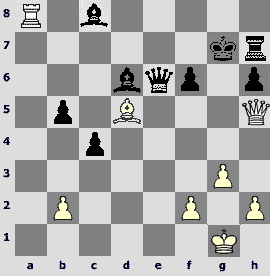

Minsk 1985, USSR championship (first league)
1.d4 d5 2.c4 e6 3.¤f3 ¤f6 4.g3 dxc4 5.Ґg2 a6 6.0–0 ¤c6 7.e3 Ґd7 8.¤c3 Ґd6 9.Јe2 b5 10.e4 e5. More careful is 10...Ґe7 11.d5 ¤b4 12.¤e5 ed5, though in this position White also posed problems for Black in the game Gelfand - Bruzon, Bled 2002: 13.a3! (13.ed5 0–0 14.a3 ¤d3 15.¤d3 Ґg4! was played before with equality) 13...¤d3 14.¤d3 cd3 15.Јd3 de4 16.¤e4.

The next game is Alexander's bright win over his old rival and one of the strongest chessplayers of the world.
Minsk 1986, USSR Spartakiad


Elista 1996, Russian championship
10...Јxd4 11.Ґb2 Јb4? (11...Јb6 12.axb5 cxb5 13.Ґd4! Јxd4 14.Ґxb7 Јxa1 15.Јxb5+ ¤bd7 16.¤xd7 ¤xd7 17.Ґxa8 Јe5 18.Јa4 Јc7 19.¦d1 Ґd6 20.¤c3 (20.Ґc6 ўe7) 20...0–0! 21.¤b5 Јb8 – Black was defending himself in this variation) 12.Јxb4 Ґxb4 13.axb5 ¤d5 14.¦c1!


Linares 1997
1.d4 ¤f6 2.c4 c5 3.d5 b5 4.cxb5 a6 5.f3 e6. The most principled response. The alternative is 5...ab5.
6.e4 exd5 7.e5. Calmer is 7.ed5. There is a completely imbalanced position on board. 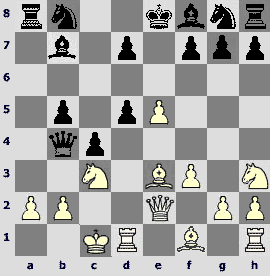
13...¤e7 14.Ґb6. 14.Јf2 which was tested later is more careful. 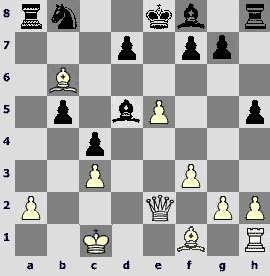
Black has only a rook and a knight for the queen, but an open position of White's king and his difficulties with developing the kingside give Alexander good chances for an attack. 


Linares 1995
1.d4 ¤f6 2.c4 c5 3.d5 b5 4.cxb5 a6 5.bxa6 g6 6.¤c3 Ґxa6 7.e4 Ґxf1 8.ўxf1 d6 9.¤f3 ¤bd7 10.g3 Ґg7 11.ўg2 0–0 12.¦e1 Јa5. Another popular plan is 12...¦a6 with subsequent Ја8 and е6.
13.h3 ¦fb8 14.¦e2. Opening the play in the center by 14. е5 is an alternative.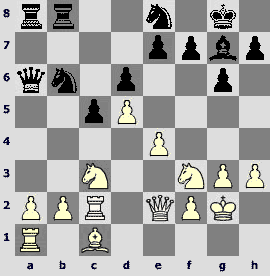


Aseev – Khalifman
St. Petersburg 1995


Groningen 1985, European junior championship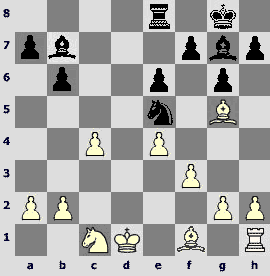


Jurmala 1982, USSR junior championship
17.h4 ¦b8. Immediate17...f5 is met by 18.Ґg5, exchanging one of the bishops.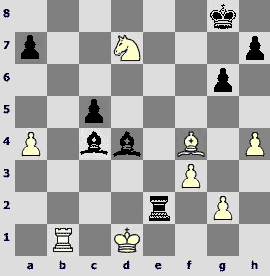
Plovdiv 1986
17.g4. It's for sure a stronger move than 17.h4 used by Naumkin.


Tilburg 1994


Lvov 1990, zonal tournament



45.ўc3 ¤c6! 46.Ґc4 (46.Ґxa6 ¤d4 47.Ґc4 ¤xf3 48.Ґxf7 ¤xh4) 46...¤d4 47.Ґxf7 ¤xf3 48.Ґe6 (48.Ґxg6 ¤xh4 49.Ґh5 ¤g2 50.Ґf3 ¤f4 51.Ґg4 ¤g6 52.Ґf5 ¤e7° with subsequent ¤с6-d4-b5) 48...¤xh4 49.Ґg4 ¤g2 50.Ґf3 ¤f4 51.Ґg4 a4! 52.bxa4 a5 53.Ґd7 ¤e2+ 54.ўd3 ¤d4° (given by Khalifman).
47.ўc3 a5 48.Ґc4 (48.Ґxg6 ¤d3!) 48...¤c6 49.Ґf7 (49.Ґe2 ¤d4 50.Ґd1 ўb5) 49...¤d4 50.h5 gxh5 51.Ґxh5 ¤e6 52.g6 ¤f4° (given by Khalifman).

Two world chess champions
Two lessons that Khalifman gave to his opponents who did not take the used variations seriously, come in conclusion.
Elista 1998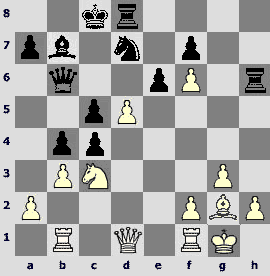
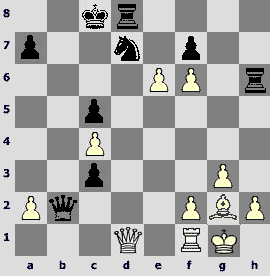
Moscow 1990
16.Ґxg7! ¦xg7 17.¦xg7+ ўxg7 18.¦g1+.
ALL ARTICLES BY AUTHOR
| S. IONOV. PORTRAIT OF A CHESSPLAYER – ALEXANDER KHALIFMAN |
| S. Ionov. Portrait of a chess player – Alexey SHIROV |
